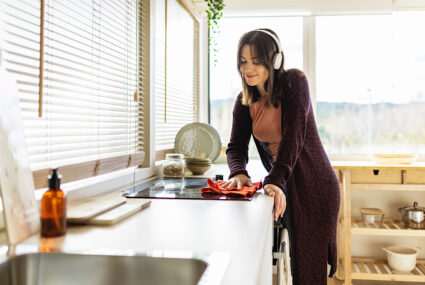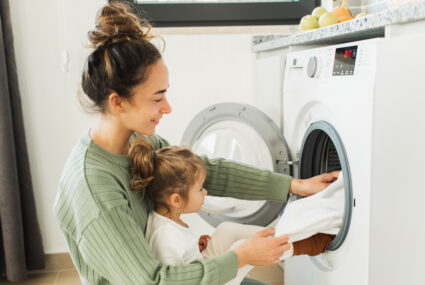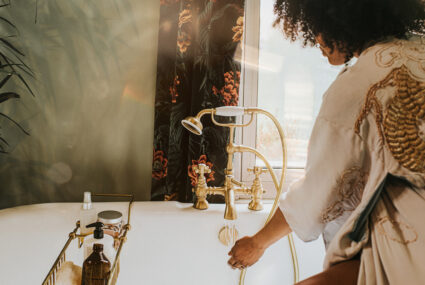‘I’ve Been Cleaning Houses Professionally for Over 20 Years, and These Are the Filthiest Spots in Your Home’
May 3, 2023
You clean your kitchen surfaces and bathroom floors, but when was the last time you thought to scrub your faucet heads or clean the dishwasher filter? These are among the dirtiest spaces in your home, but they often go uncleaned because people don’t know they need to be cleaned—or they aren’t cleaned thoroughly enough.
With this in mind, Sara San Angelo, a professional house cleaner with over 20 years of experience and owner of the blog Confessions of a Cleaning Lady, and Melissa Maker, a cleaning expert behind the blog Clean My Space, share eight of the dirtiest spaces in your home and how to clean them.
The 8 dirtiest spaces in your home, according to cleaning professionals
1. Faucet heads
You need to give your kitchen and bathroom faucets the same level of attention you would a shower head. All faucets are susceptible to hard water deposits, mineral buildup, and mold. “People don’t think to clean their faucet heads because they don’t see these places, but they can get very dirty and moldy,” says San Angelo. “This is a very important place to clean—you do everything from wash dishes to brush your teeth with the water coming out of that.”
How to clean faucet heads
Related Stories

‘I’m a Professional Cleaner, and You Can Skip These 5 Products That…

You’re Cleaning Your Dryer Filter, But Have You Cleaned Your (Probably Smelly…

You’re Probably Not Washing Your Tub Thoroughly—This Viral Electric Scrubber Will Make…
Fill a plastic bag with equal parts distilled white vinegar and water. Submerge the faucet head with the solution and use rubber bands to secure the bag to the fixture. Let it soak in place for up to 30 minutes. After removing the plastic bag from the faucet head, remove loose debris with a cleaning solution like the Clorox Disinfecting All-Purpose Cleaner ($4) and a small scrub brush or soft-bristle toothbrush.
2. Dishwasher filter
You’d think that your dishwasher would clean itself, but a dirty dishwasher filter can prevent it from doing its job well. “If you notice your dishes aren’t coming out clean, it’s a good indicator that you need to clean your filter,” Maker says. She notes that older models don’t typically have these, but in newer models, it’s a mesh container located in the bottom of your dishwasher. To see if you have one and how to remove it, it’s best to check the manufacturer’s instructions for your model.
How to clean a dishwasher filter
Remove the dishwasher filter before cleaning it. “Typically, you unscrew the filter, pull it out, and soak it in the sink with hot soapy water. You can use a cleaning toothbrush to scrub the mesh, and then just put it back,” Maker says. “You’ll notice your dishwasher runs so much better. You won’t get that grittiness on your glasses and things stuck to your plates.”
3. Door and window frames
There are some spaces in a home that people don’t often think (or want) to clean because they are so hard to reach, but dust and dirt will accumulate anywhere it can land. “Any horizontal space in your home will collect dust,” says San Angelo. “This goes for tops of doors and window frames.” While the idea of cleaning door and window frames can seem like an added chore, it can be done quickly and efficiently with one or a couple of cleaning products.
How to clean door and window frames
Simply, go over door and window frames with a dry microfiber cloth or a duster to remove debris. If your door and window frames are out of reach, consider using a duster with an extendable pole. One option that San Angelo recommends is the Swiffer Heavy Duty Extender Handle Starter Kit ($19), which extends up to three feet and comes with 12 dusters.
4. Exterior windows, screens, and interior window sills
Maker says that cleaning your exterior windows not only gets rid of visible smudges and dirt, but it can make a marked difference in your home. “The other day I went around the house and I did all my exterior windows … We have a beautiful backyard, but it can be really hard to enjoy if the windows are dirty,” she says. “Once I cleaned them, it just made all the difference—the inside of the house sparkled.” While this cleaning task is more involved, it’s well worth the time and extra effort.
How to clean exterior windows, screens, and interior window sills
Maker says you’ll need a double-sided window squeegee and an extension pole, like these: Ettore Complete Window Washer ($12) and Ettore 16 ft. Reach Extension Pole ($28). Fill a bucket with warm water, a tablespoon of dish soap, and a cup of white vinegar. Dip the spongy side in the bucket, wash the window, and then flip the window washer to squeegee off the water. “Each window takes about 30 seconds,” she says, adding that the extension pole allows you to tackle second-story windows without needing a ladder.
Next, you can pop your window screens out and scrub them in the bathtub with dish soap and an Iron Handle Scrub Brush ($7). “Screens catch things like dirt, dead bugs, little pieces of plants—they can just get really dirty over time.” You can do the same with screen doors by scrubbing with the iron handle brush dipped in warm soapy water, and removing the soap and debris with a wet Microfiber Cleaning Cloth ($15).
You’ll also want to show your window sills some love. “When your windows are open and closed, and open and closed, dirt blows in and it lands on the sill,” she says. Start by loosening up any dirt with a cleaning toothbrush, vacuum the sill using a brush attachment, and wipe it down with a damp cloth. Maker cleans her exterior windows and screens once or twice a year, and cleans her sills whenever they’re visibly dirty.
5. Lightbulbs
When was the last time you’ve cleaned a lightbulb? (My answer would be “never.”) You may want to make it part of your cleaning routine—they are prime dust magnets. “You don’t normally see your lightbulbs, but along with light fixtures, they can get very dusty,” says San Angelo. She adds that a dusty, grimy bulb can significantly lessen the amount of light it casts. So, before you even think about changing a lightbulb, you may want to try cleaning it first.
How to clean lightbulbs
Turn off the lightbulb and allow it to cool before cleaning. Dust the lightbulb using a duster, but if the dust is stuck on (“It happens sometimes in kitchens where there is a lot of grease accumulation,” says San Angelo”), remove it from the socket of the fixture and carefully wipe the bulb down with a damp rag. Dry the lightbulb before putting it back into the socket.
6. Behind your TV
When it comes time to clean your TV, the first thing you probably think to tackle is the TV screen, which is prone to unsightly smudges and dust. The same goes for behind the TV, though, and “just because you don’t see it doesn’t mean dust won’t accumulate on it,” says San Angelo. It probably doesn’t get much exposure to the elements, but it’s still important to keep it clean. When dust accumulates in the vents, nooks, and crannies in the rear, it can keep a TV from performing at its prime.
How to clean behind your TV
Turn off your TV and make sure it’s completely cooled down before you start cleaning. Using a dry microfiber cloth or a duster, gently wipe down the back of your TV, paying special attention to the vents and any tight corners and other hard-to-reach places. Perform this task weekly or every other week to ensure that it stays dust free.
7. Shoe closets and doormats
Maker says your doormats and shoe closets trap tons of dirt and debris that you track into the house on your shoes. “You can bring allergens in, you can bring in dirt, just unwanted stuff comes in,” she says. A 2008 study from the University of Arizona, funded by The Rockport Shoe Company, found that the average shoe sole is covered with 421,000 bacteria and that 90 percent of the time, bacteria transfers directly to clean tile floors—an excellent reason to clean your doormats and shoe closets more often.
How to clean shoe closets and doormats
“I don’t always vacuum every room every time I vacuum, but I always vacuum those mats. Because keeping those clean keeps the rest of my house much cleaner,” Maker says. The floor of a shoe closet can also get really gritty with dirt and debris, Maker says. While they don’t have to be cleaned as frequently, you’ll want to aim to vacuum it three to four times a year.
8. The floor around the toilet
You know the importance of cleaning your toilet, but what may be unbeknownst to some is that the job extends to the surrounding area. One spot that is easy to miss? The space around the toilet. “This spot is sometimes out of sight but can collect lots of grime,” says San Angelo. While you’re at it, you may also want to clean behind the toilet, which is among the dirtiest places in the bathroom. “It can just be a place where germs and dirt can be harbored,” Branch Basics co-founder Marilee Nelson previously told Well+Good.
How to clean the floor around the toilet
Using either cleaning wipes or a combination of cleaning solution and a rag or a power towel, wipe down the toilet base where it meets the floor. You may want to clean the floor around the toilet, which may also be dirty. Don’t forget to read the instructions on the cleanser label to find out how long it should stay on a surface to effectively kill germs and for proper usage.